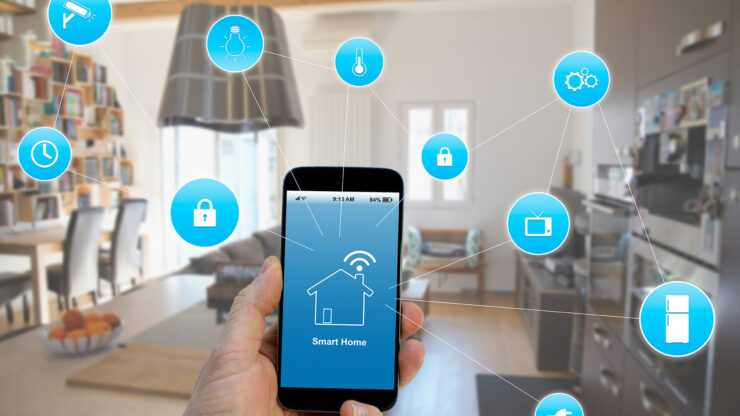Family and consumer sciences, also known as home economics, have undergone significant changes over time as new technologies have been introduced, including high-speed internet access. The integration of technology has revolutionized the way home economics is taught and practiced, offering numerous benefits and expanding its scope.
In this article, we will discover how home economics has improved due to improved technology and high-speed internet, revolutionizing various aspects of daily life.
Indeed, technology and high-speed internet have revolutionized learning in all spheres of life, opening up new opportunities and transforming the way knowledge is accessed and acquired. You can easily explore online courses, tutorials, and forums tailored to home economics education, which also allow you to acquire practical skills and knowledge at your own pace and ease.
Now let us explore how home economics has evolved and improved over time.

1. Enhanced Access to Information and Resources
One of the most significant ways technology and the internet have improved home economics is through enhanced access to information and resources. With a few clicks, individuals can now access a wealth of knowledge, recipes, instructional videos, and research on various home economics topics. High-speed internet allows you to do quick searches, ensuring that information is readily available at one’s fingertips.
Whether it’s finding healthy recipes, learning new cooking techniques, or exploring budgeting strategies, the internet has made information accessible to individuals seeking to improve their home economics skills.
2. Online Learning Platforms and Courses

Technology has facilitated the rise of online learning platforms and courses, revolutionizing the way home economics is taught and learned. Individuals can now enroll in virtual classes and workshops on various aspects of home economics, such as cooking, nutrition, financial literacy, and interior design.
Online platforms offer flexibility, allowing learners to access course materials at their own convenience. You only need a device/gadget and a reliable internet connection like Mediacom to access courses. With lightning-fast speed and pocket-friendly Mediacom Internet plans, you can dive into a world of virtual resources and interactive platforms without any interruption that will enhance your understanding.
A reliable and robust internet plan with a strong connection is of paramount importance for effective and seamless work from home arrangements. In the modern era, where remote work is increasingly prevalent, a good internet plan ensures uninterrupted communication, collaboration, and productivity.
Strong internet connection facilitates smooth video conferencing, enabling virtual meetings and discussions with colleagues, clients, and stakeholders. It ensures that crucial information is transmitted in real-time, preventing misunderstandings and delays. Dependable internet plans ensure quick access to cloud-based tools and applications, allowing remote workers to efficiently share and access files, collaborate on projects, and maintain productivity.
Stable internet is essential for accessing important company resources, databases, and online platforms securely. It safeguards against data loss, reduces downtime, and minimizes the risk of technical glitches that could disrupt workflows.
Furthermore, cooperative features, such as discussion forums and video demonstrations, create an engaging learning environment. This way it also helps in easing knowledge acquisition and skill development.
3. Virtual Demonstrations and Tutorials

Technology has introduced virtual demonstrations and tutorials, enriching the learning experience in home economics. Through high-quality video platforms like YouTube and specialized websites, individuals can access step-by-step tutorials, cooking demonstrations, and DIY projects.
These visual resources provide clear instructions, allowing learners to follow along and gain practical skills in real-time. Virtual demonstrations have made home economics more engaging and interactive, providing different learning styles and fostering a sense of confidence and independence among learners.
4. Smart Home Technologies

The integration of smart home technologies has significantly transformed the way individuals manage their households and aligns with the principles of home economics. However, smart appliances, such as refrigerators with inventory management systems and ovens with built-in recipe databases, have streamlined meal planning and preparation.
Luckily, these technologies can offer nutritional recommendations, suggest recipes based on available ingredients, and even adjust cooking settings for optimal results. Moreover, smart home technologies promote efficiency, reduce waste, and simplify the management of resources within the household.
5. Mobile Applications for Meal Planning and Budgeting

The availability of mobile applications has changed meal planning and budgeting. These apps allow users to create meal plans, generate shopping lists, track expenses, also ensure a well-balanced diet. They provide access to a vast library of recipes, nutritional information, and pricing data.
In addition, some applications also offer personalized recommendations based on dietary restrictions, preferences, and financial goals. Mobile apps have made meal planning and budgeting more convenient and accessible, allowing individuals to make informed choices and optimize their resources.
6. Online Marketplaces and Delivery Services

Technology and high-speed internet have facilitated the growth of online marketplaces and delivery services, altering the way individuals shop for groceries, clothing, and household items. Online platforms like Amazon, Instacart, and Etsy offer a vast selection of products, allowing individuals to compare prices, read reviews, and make informed purchasing decisions.
Delivery services bring convenience and time-saving benefits, ensuring that essential items are readily available without the need for physical shopping. These advancements in e-commerce have expanded options for sourcing ingredients, materials, and tools necessary for home economics projects.
7. Virtual Communities and Sharing Platforms

The internet has given rise to virtual communities and sharing platforms that bring together individuals with shared interests in home economics. Social media platforms, specialized forums, and websites dedicated to home economics raise a sense of community, allowing individuals to connect, share ideas, and seek advice.
Moreover, virtual communities provide a space for individuals to showcase their projects, seek inspiration, and receive feedback. These platforms facilitate collaboration, learning, and support among home economics enthusiasts, enriching the overall experience and expanding the community’s knowledge base.
Conclusion
Home economics has significantly improved the lives of citizens by promoting healthier lifestyles, enhancing financial literacy, encouraging sustainable living practices, equipping individuals with essential life skills, strengthening family relationships, creating career opportunities, fostering community engagement, and promoting empowerment and independence.
The knowledge and skills gained through home economics education have a lasting impact on individuals, enabling them to lead healthier, more sustainable, and fulfilling lives.

